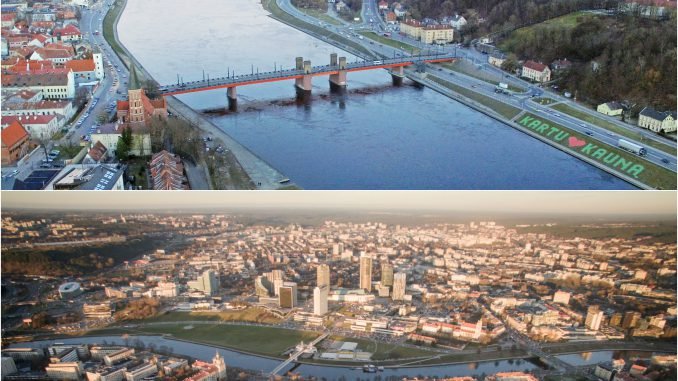
If we were to measure quality of life based on GDP per capita, Lithuanians would have nothing to complain about.
At least this is what economists from the bank Luminor state in their newest review of the Lithuanian economy, which they presented on Tuesday.
The new review Prospects for Baltic States’ Economies predicts that the Lithuanian GDP will grow by 3.3% this year, while in neighbouring Latvia and Estonia – 4.2% and 3.5% respectively.
The favourable conditions for the Baltic States’ economies to grow are based on the rapid growth of the Eurozone and economic and consumer expectation metrics reaching historic heights.
Luminor analysts note that one of the premises for the improved GDP growth forecasts is the faster than expected expansion in export markets and domestic consumption resisting the challenges of inflation.
“Inflation limited appetites for consumption at the end of last year and led to concerns that Lithuania may enter stagflation and end up in a spiral of rising prices and wages, which would eventually harm the country’s international competitiveness. However the most recent data reveals that this challenge was overcome,” Luminor chief analyst Indrė Genytė-Pikčienė said.
Inflation is levelling out and this trend will become more notable this year. A more moderate growth in “imported” inflation and more modest changes in excises allow predicting that this year average annual inflation will slow down to 2.5%.
“The Lithuanian presidential and municipal elections to be held in 2019 will raise the topic of wages. The example of Latvia and Estonia of raising the minimum wage will be highly tempting and wage policy in important public sector areas such as education and healthcare have matured for fundamental change. Considering this, wages are predicted to grow 6% in 2018 and accelerate to 8% growth in 2019,” the analyst said.
According to her, the last year was particularly successful for Lithuania due to a spike in foreign investment. Apparently, the “Kaunas effect” had an impact on this. Furthermore, last year Lithuanian companies made record-breaking investments into vehicles and machinery. This will allow businesses to pursue effectiveness and easier handle the rising expenses for employee wages.
Continued export growth, domestic consumption and investment also make room for optimism.
I. Genytė-Pikčienė highlighted that last year the growth of the real estate market declined. There are signals that the home prices in Vilnius have reached the level, which was seen prior to the crisis and that the market has sated itself.
Myths of the present and the historic truth
Luminor chief economist Žygimantas Mauricas emphasised that the greatest challenge to the Lithuanian economy currently is undeservedly pessimistic expectations regarding long-term economic prospects, which among other things are propagated by self-blame myths spread in public discourse.
The first self-blame myth, which can often be heard, both in private and public conversation is that of “indebted Lithuania”. In actuality, the truth is that Lithuania is among the EU states with the lowest public and private sector debts and financial discipline legislation prevents politicians from overspending even during economic growth. Respectively, the government sector budget balance appears to likely be surplus in both 2018 and 2019 despite the upcoming electoral season.
The second self-blame myth is that of the ending EU support and how the Lithuanian economy will supposedly be struck by economic crisis. “Actually the truth is that depending on the outcome of negotiations, EU support for Lithuania in 2021-2027 may only decrease 20-30% and the direct grants for agriculture may even rise. Respectively the negative effect of reduced EU support would amount only to 1-1.5% GDP, thus a third of the economic growth of 2017,” the economist commented.
The third is the myth of “vanishing” Lithuania. The truth is that the ongoing demographic changes (population aging, low birth rates) is little different from other Western countries (Japan, China and Germany are faced with far greater challenges) and the trends of migration from smaller cities and rural areas to large urban centres are observable in almost all Western countries (even in Scandinavia, whose countries have among the lowest income inequalities).
Furthermore, for the past 6 years, the population of Vilnius has been rapidly growing and Kaunas, which has been drawing increasing investment recently, could also become a centre of gravity.
“Finally, historical analysis shows that Lithuanians have not been this well off for 424 years. The Lithuanian GDP per capita has reached 72% of the Western European average (last time this was the case in 1594),” Ž. Mauricas pointed out.
He highlighted that during its heyday, the Lithuanian GDP per capita was only 86% of the Western European average. It is interesting that the lowest point was only 25 years ago in 1993 when the Lithuanian GDP was only 28 of the Western European average. As such it is necessary to emphasise that Lithuania has made massive strides in the past quarter century. Speaking of the future, Lithuania only needs around 3.5% average annual economic growth so that GDP per capita would be comparably better than ever before (reaching a second golden age – 86% of the Western European average) and around 5% if it seeks to catch up to the Western European average.
At the same time, he pointed out that while Lithuania is catching up to Western Europe in GDP per capita, the percentage of this economic growth contributing to wages is still a fair distance behind countries such as Switzerland and Denmark.
A significantly greater part of the value generated in these countries goes to employees. Our country could improve this metric if social insurance payments were reduced; in the aforementioned countries, they are far lower.
